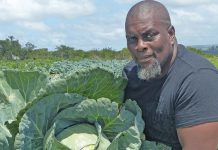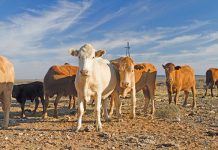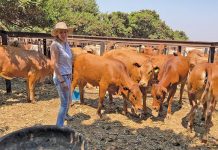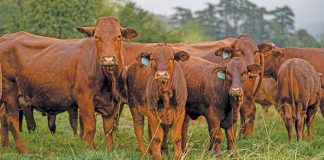
Riaan Randles’s farm nestles in the mountainous eastern Free State between the towns of Memel and Harrismith. The veld is sour and dense.
Randles started in 2002 as a part-time farmer with 56 Angus cattle and subsequently resigned his Johannesburg-based job in 2012 to farm full-time, by now with 1 500 Brahman-Angus cattle on 3 000ha of land.
Rian van Wyk started farming near Panbult on the Mpumalanga Highveld in 1980 and added the Jagtdrift Brangus stud to his commercial herd in 2003.
He currently runs 520 registered Brangus females alongside 930 commercial females. Maize and soya bean are his main sources of income, although pine and eucalyptus timber contribute to diversification. The Mpumalanga escarpment’s high rainfall, sandy soil and sour veld favour a mixed farming operation.
Baling camps
Randles cuts and bales his vlei grass and Eragrostis pasture as winter feed. He cuts vlei grass rather high above the ground, leaving between 25cm and 45cm as standing hay. “I keep the cattle close to the baling camps and don’t move bales more than one kilometre,” he explains.
Randles stores the bales strategically in 10 different bale camps. With veld fire a perpetual risk, this strategy prevents his entire fodder bank from being destroyed in a single fire.
“I try to retain bales for as long as possible by feeding only cows with calves,” he explains.
“Cattle that deteriorate rapidly in condition during winter are removed from the herd and also given the bales. “It makes better economic sense to improve their condition and then sell them, rather than cull.”
Randles produces 2 000 to 2 500 bales annually and starts using them in August. Vlei grass accounts for 1 000 bales, and Eragrostis the balance.
The latter is higher in protein, which is important for condition and energy in cattle. Other grasses may be higher in protein than Eragrostis but are more difficult to manage.
When establishing Eragrostis, Randles mixes the seed with that of teff. “Teff is an annual species, while Eragrostis takes two years to reach full production.
This way, I have both species of grass in the first season and pure Eragrostis in the second. The local co-op knows what Eragrostis cultivar is suited to local conditions.
“For me, maize stover is a crucial resource. After harvesting, I put cows with three-month-old calves onto the stover. This improves their milk production and general condition. Cows on maize stover show a real difference. I keep them there until the next planting,” he explains
Soya beans
In contrast, Van Wyk bales soya bean crop residue directly behind the harvester so that it does not have to be cut and raked like grass hay.
This saves R220/ha.
“We recover soya bean residue at 16 bales/ha and about 220kg/bale. With the value being at least R200/ bale, this is R3 500/ ha. From an agronomic point of view, crop residue should remain on the land. But cattle and soil compete for this resource and in our case, the cattle win,” he says.
Van Wyk admits that using crop residue as stock feed is not without its cost: additional fertiliser at R380/ ha replaces nutrients thus removed from the land. He feeds baled residue taken from his 800ha soya bean lands and grazes cattle on all the maize stover.
Summer grass, winter lick
Van Wyk says that standing veld grass is the cheapest winter feed so he keeps spare camps specifically for this purpose. However, on its own this is not enough, so he supplements it with a protein winter lick.
He also supplies a phosphate supplement throughout the year, as soil analysis of his land shows a phosphate content of only three parts per million. This is due to high local rainfall leaching the phosphate out of the soil, a problem that occurs in the Panbult area.
Sourveld has almost no protein and requires a good winter lick with between 10% and 45% protein, depending on the area, as well as additional energy supplied in the form of maize grain. Randles uses Dundee P12, a concentrated Voermol winter lick, mixed with ground maize and sea salt. This concentrated form of lick also saves on transport cost.
Randles uses Dundee P12, a concentrated Voermol winter lick, mixed with ground maize and sea salt. This concentrated form of lick also saves on transport cost.
He prefers mixing the lick manually with a shovel on an open shed floor rather than using mechanised mixing. The mixing guidelines provided by feed companies can be relied upon, he says. “Farming is complex – a farmer cannot know everything!”
Maize too costly to buy in
Randles started planting maize in 2011 and currently plants 150ha, harvesting 3,5t/ha. He sells some to cover production costs and keeps 60t to grind for feed. Before 2011, he bought in maize for winter feed but when the price hit R3 000/t he realised it was more profitable to produce it.
“One can’t say planting or buying is better,” he says. “A farmer has to look at his own needs and circumstances and make a decision based on that. I store maize grain in my own dam silos and keep it back till the price is right for sale – around R2 200/t out of hand.” He only feeds maize after having assessed the animals’ condition, and gives it as needed.
Silage preferred
Van Wyk started making silage four years ago. “Silage is king,” he states. “Cattle find it quite palatable. It’s not affected by frost, can’t burn, and can be stored for up to six years. We grow 36ha of silage maize annually and hire a contractor with machinery to harvest and process it in two days. One hectare produces 55t wet maize silage, enough to feed 40 head of cattle for 100 days at 12kg/LSU per day.”
Silage starts with growing good quality maize, preferably a recommended silage cultivar that can deliver good grain yield. The cultivar has to combine vegetative biomass with sufficient carbohydrates in the form of grain. The maize has to be harvested at the appropriate physiological stage – the hard dough stage – where only the first few kernels show indentation.
The silage bunker must be properly filled, compacted and covered within two days. When filling and compacting, a special silage inoculant mixed with water and sprayed over the chopped maize can be added to speed up fermentation.
When finished, the silage has to be covered with a modern white silage tarpaulin that reflects heat so that the outer layer does not heat up and spoil. The silage should lie on an inclined surface soil so that moisture build-up drains away and does not rot the silage from the bottom. Silage has to mature for at least ten weeks before use.
It’s all about condition
Both farmers agree on the importance of rationing. Van Wyk provides two days of silage at a time, but ensures that the cattle eat everything. Randles supplies another bale only once the previous bale has been completely eaten. Cattle are finicky eaters that will eat only the really palatable parts and waste the rest if there is too much to choose from.
Both farmers concur that feeding rations require that cattle in the same condition be placed together, as they share the same eating pattern. An important aspect of overwintering is to ensure that the cattle are in good condition before winter really commences. Condition is scored by looking at the amount of fat and muscle on the animal on a scale of 1 to 5.
“I try to keep all cattle above three,” says Randles. “Below this, it takes too long to get the condition back up again. Cattle in low condition are less fertile and more susceptible to parasites. Mortality is higher, influencing the next season. If the condition is low, a farmer has to do whatever it takes to feed and improve it.”
Van Wyk aims for a conception rate of at least 85% in the herd. With cows in low condition, this figure may drop to 60%.
After calving, a cow needs supplementation to produce sufficient milk. Young and lactating animals always require the best feed. Bulls need supplements after the first breeding season to get into a condition score above three. Dry cows require less supplement.
Both farmers agree, however, that winter feed or supplements may amount to nothing unless cattle are free of parasites.
“Everything works together, not just feed. My advice to farmers is to ask a vet about when it’s the best time to treat for a particular parasite. Or read up on it,” Randles suggests.
Learn from mistakes
Randles recalls how one year, to save cost, he withheld winter feed and lick. “The cows’ reconception rate plummeted, and the condition of the herd declined. The input cost to get the cattle back in condition again was huge.” He also cautions against believing everything that salesmen say.
“I once received advice on pest control for my maize that was better suited to a large commercial maize farmer. Because of this, my pesticide bill was 20% to 25% of the total production cost without showing better results. I now restrict the pesticide cost to between 10% and 15% of the total input cost.”
With lick, says Randles, it is important to follow instructions.
“Study the composition. For example, urea is highly toxic when too concentrated. If it’s used unwisely, cattle can be poisoned.”
Van Wyk stresses that unproductive animals should be offloaded as soon as possible, and only quality productive animals retained. He fattens all culls in his feedlot with self-produced balanced feed. He has also learned that a one-size-fits-all feeding system does not work and that young steers, culled cows and growing bulls should be fed differently according to their specific needs.
Specific farm, specific problems
Van Wyk’s farm has wattle growth in his veld and pastures. Although he has eradicated most of it, shoots still sprout each year. As the wattle contains tannins that upset digestion in cattle, Van Wyk adds a tannin inhibitor, Browse Plus, to his winterlick at 400mg per 50kg.
This aids digestion and improves intake of coarse grass, soya bean residue and wattle – all of which ensure better cattle growth and production.
Van Wyk aims to eventually eradicate the wattle. Randles has other problems. The Memel area has very cold and abnormally long winters; this year, frost arrived on the Easter weekend. The minimum temperature can often stay sub-zero until November.
Start early
“Spare veld is my first option for winter feed,” says Van Wyk.
“But it’s difficult to rely on it in yearly planning. I can’t predict rainfall, or whether a veld fire might burn it all. So I start firebreaks and get ready to fight fires on my farm, or wherever they occur in the district.”
He advocates that farmers follow a philosophy of continual learning. In his case, he consults specialists, a veterinarian, and an objective feedlot and cattle expert annually. “Start planning early, decide how many head need to be wintered, take inventory of resources, and get busy,” he advises.
Email Rian van Wyk at www.jagtdriftbrangus.co.za and Riaan Randles at [email protected].












